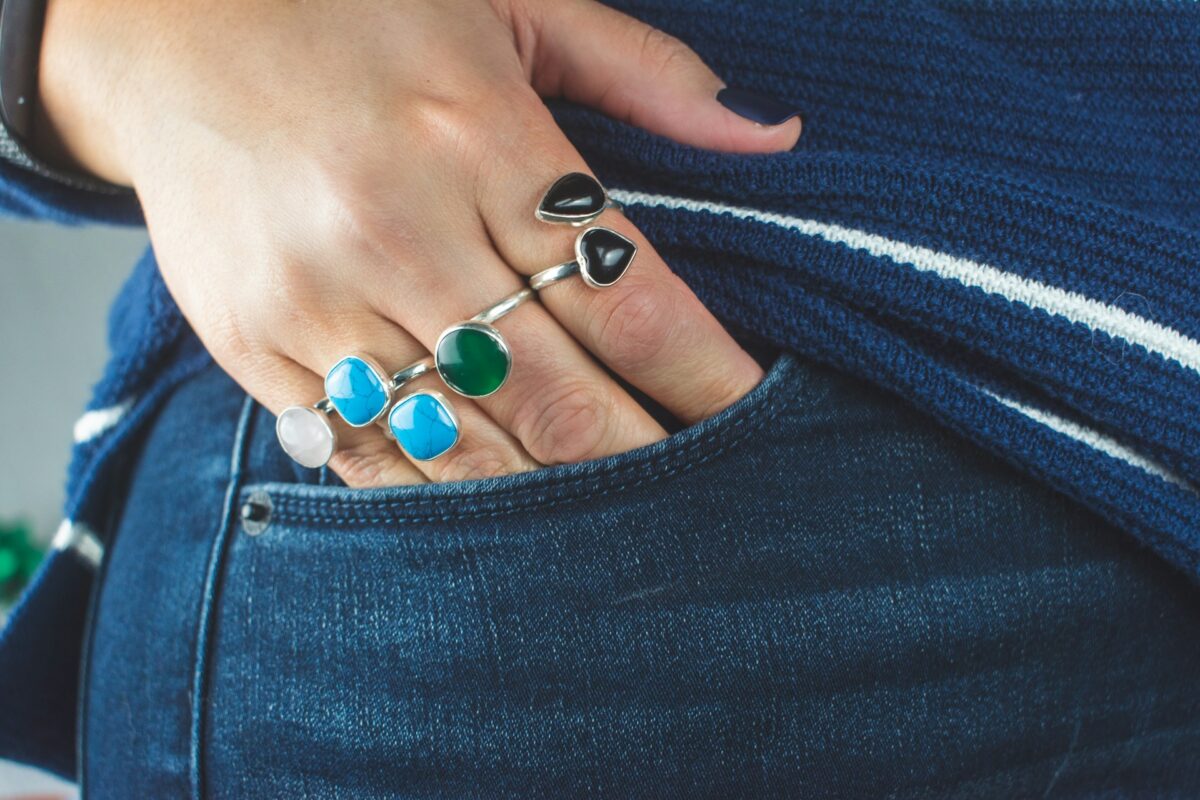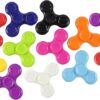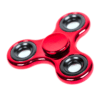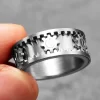Anxiety Rings
Finding Peace in the Palm of Your Hand: Exploring the Benefits of Anxiety Rings
In today’s fast-paced and stress-filled world, finding moments of peace and tranquility can seem like an impossible task. That’s where anxiety rings come in. These beautiful and small accessories may be the key to helping you find a sense of calm and grounding throughout the day. Anxiety rings, often known as worry rings or fidget rings, are designed to provide a comforting sensation when rolled or spun between your fingers. They feature a unique design that combines style with functionality, making them discreet tools for managing anxiety and stress. Check out our collection of anxiety rings here.
The Benefits of Anxiety Rings
Not only do anxiety rings offer a tactile experience that can help distract and calm the mind, but they can also serve as a gentle reminder to take a deep breath and focus on the present moment. With their convenient size, they can easily be carried in your pocket or worn as a stylish accessory, allowing you to access their benefits anytime, anywhere.
By exploring the benefits of anxiety rings, you may discover a new way to find inner peace in the palm of your hand. So why not give it a try and experience the positive impact they can have on your overall well-being?
What are anxiety rings?
Anxiety rings, also known as worry rings or fidget rings, are small, discreet accessories designed to provide a calming and grounding sensation for individuals dealing with anxiety, stress, or nervous habits. These rings are typically made of various materials, such as metal, silicone, or even natural stones, and feature a unique design that allows the wearer to roll, spin, or manipulate the ring between their fingers.
The concept behind anxiety rings is to offer a tactile and sensory experience that can help distract the mind from negative thoughts, worries, or anxious feelings. By focusing on the physical sensation of the ring and the repetitive motion of rolling or spinning it, the wearer can shift their attention away from the source of their anxiety and find a sense of calm and focus.
These rings are increasingly becoming popular among individuals of all ages who are seeking effective and convenient tools to manage their mental health and well-being. They are often used as a discreet and portable alternative to other fidget toys or stress-relieving devices, allowing the wearer to access their calming benefits anytime, anywhere.
Understanding anxiety and its effects
Anxiety is a widespread mental health condition that affects millions of people worldwide. It is characterized by persistent feelings of worry, fear, and unease that can interfere with daily life, work, and relationships. Anxiety can manifest in various ways, such as physical symptoms like rapid heartbeat, sweating, or muscle tension, as well as cognitive symptoms like racing thoughts, difficulty concentrating, or irrational worries.
The effects of anxiety can be far-reaching and can have a significant impact on an individual’s overall well-being. Chronic anxiety can lead to various health issues, including sleep disturbances, digestive problems, and even cardiovascular complications. Additionally, anxiety can negatively impact an individual’s emotional and social well-being, making it challenging to maintain healthy relationships, engage in hobbies, or pursue personal and professional goals.
Understanding the root causes and triggers of anxiety is crucial in developing effective coping strategies. Factors such as genetics, life experiences, stress levels, and environmental factors can all contribute to the development and persistence of anxiety. By recognizing the unique challenges and needs of individuals dealing with anxiety, we can better support them in finding healthy ways to manage and overcome their struggles.
The benefits of using anxiety rings
Anxiety rings offer a range of benefits for individuals seeking to manage their anxiety and stress levels. One of the primary advantages of these accessories is their ability to provide a calming and grounding sensation through the tactile experience of rolling, spinning, or manipulating the ring.
The repetitive motion of the ring can help redirect the mind from negative thoughts or worries, allowing the wearer to focus on the present moment and find a sense of calm. This can be particularly beneficial for individuals who struggle with intrusive thoughts or difficulty concentrating, as the physical sensation of the ring can serve as a distraction and a way to anchor the mind.
In addition to their calming effects, anxiety rings can also contribute to improved self-regulation and emotional control. By providing a tangible object to fidget with, the wearer can channel their nervous energy or restlessness into a constructive and mindful activity, rather than engaging in unhealthy coping mechanisms. This can lead to a greater sense of control and mastery over one’s emotional state, which can have a positive impact on overall well-being.
How anxiety rings work
Anxiety rings work by providing a tactile and sensory experience that can help individuals manage their anxiety and stress levels. The unique design of these rings allows the wearer to roll, spin, or manipulate the ring between their fingers, creating a repetitive motion that can have a calming and grounding effect.
The physical sensation of the ring against the skin can trigger a response in the brain, activating the parasympathetic nervous system, which is responsible for the body’s “rest and digest” functions. This can lead to a reduction in physiological symptoms of anxiety, such as a racing heartbeat, sweating, or muscle tension, as the body enters a more relaxed state.
Furthermore, the act of focusing on the movement and sensation of the ring can help shift the mind’s attention away from negative thoughts or worries, allowing the wearer to be more present and mindful. This can be particularly beneficial for individuals who struggle with rumination or intrusive thoughts, as the ring provides a tangible object to redirect their focus.
Ultimately, the effectiveness of anxiety rings lies in their ability to engage multiple senses and provide a simple, yet powerful, tool for self-regulation and stress management. By incorporating these rings into their daily routine, individuals can access a convenient and discreet resource to help them find moments of calm and focus throughout their day.
How to choose the right anxiety ring for you
When it comes to selecting the right anxiety ring, there are several factors to consider to ensure it meets your specific needs and preferences. The first and most important aspect to consider is the material of the ring, as this can significantly impact the sensory experience and overall feel.
Common materials used for anxiety rings include metals (such as stainless steel, copper, or brass), silicone, and natural stones (like obsidian or amethyst).
Each material offers a unique texture, weight, and level of smoothness, which can appeal to different individuals. For example, metal rings may provide a more substantial and satisfying fidgeting experience, while silicone rings offer a softer and more pliable sensation.
Another important consideration is the design and style of the ring. Anxiety rings come in a wide range of shapes, sizes, and patterns, allowing individuals to choose a design that resonates with their personal aesthetic and preferences. Some rings feature smooth, continuous surfaces, while others have textured or grooved patterns that can add an extra layer of sensory stimulation.
Other tools and techniques for managing anxiety
While anxiety rings can be a powerful tool in managing anxiety and stress, they are not the only option available. There are a variety of other techniques and strategies that individuals can explore to find relief and improve their overall well-being.
One effective approach is the practice of mindfulness and meditation. By learning to focus on the present moment and cultivate a non-judgmental awareness of thoughts, feelings, and physical sensations, individuals can develop a greater sense of control over their anxiety. Mindfulness-based exercises, such as deep breathing, body scans, or guided meditations, can help individuals calm their minds and find a sense of inner peace.
Another valuable tool for managing anxiety is the implementation of healthy lifestyle habits. Things like regular exercise, a balanced diet, and adequate sleep can all contribute to improved mental health and resilience in the face of anxiety. Additionally, engaging in activities that promote relaxation and stress relief, such as yoga, journaling, or spending time in nature, can be highly beneficial.
For individuals who are struggling with more severe or persistent anxiety, seeking professional support from a mental health professional, such as a therapist, hypnotherapist or counselor, can be a crucial step. These experts can provide personalized guidance, evidence-based treatments, and a safe space for individuals to explore the root causes of their anxiety and develop effective coping strategies.






